Research project
Experimental project Huize Horsterwold
The project’s main aim was to build a reconstruction of a prehistoric house plan, without using any metal tools. How effective are tools made of stone, flint, bone, antler and wood? What are the constraints imposed by the various building materials? How much labour do we need and how much knowledge and skills are required? How much time do the various phases of the production process take? How do the various steps of the building process interrelate in terms scheduling and is it possible to make a complete chaîne opératoire of the entire building process?
- Contact
- Annelou van Gijn
- Funding
- Prins Bernhard Cultuurfonds financed the project, whereas the Forestry Service provided logistical support.
- Partners
National Forestry Service of the Netherlands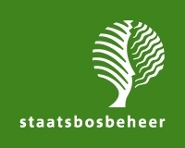
Prins Bernhard Cultuurfonds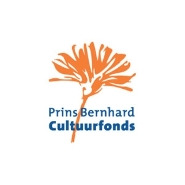
Het Stenen Tijdperk
Municipality of Zeewolde
Heritage Centre Nieuwland
Short abstract
Building a Stone Age house using only Stone Age tools is unique in Europe and has taught us a great deal about tool use, the amount of labour and material and the knowledge and skills required. It was also a great experience for students and local volunteers.
Social relevance
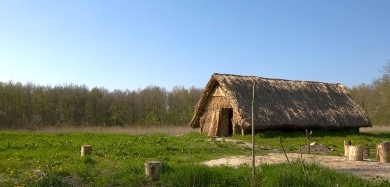
The construction of the Horsterwold House has enabled the inhabitants of Zeewolde to experience a complex scientific experiment in their own forest. Some participated in the actual building, others regularly frequent the place on their cycle trips. School classes visit the house under supervision of the Forestry Service, where they are taught about ancient fire making, the manufacturing of ropes from tree bark and other archaeological techniques.
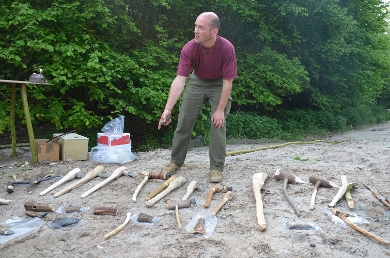
The house has also embellished the forest and has given the Forestry Service a place to host visitors, from school classes to various trainings. It has also helped students to become better archaeologists, by expanding their horizon and teaching them not only what kind of material culture categories there are, but also how material culture functions in a living context. Students also had to answer the questions of visitors, which gave them the opportunity to learn how to inform communities about archaeological projects.
Scientific relevance
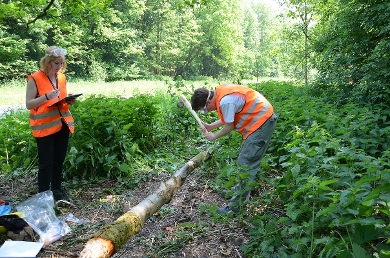
The Horsterwold House provides more insight in the different aspects of building a house with replicas of Stone Age tools. It can give us an indication about the amount of materials that can be used in building such a house, as well as how many hours it takes to construct a house. The tools also play an important role.
Why Leiden University?
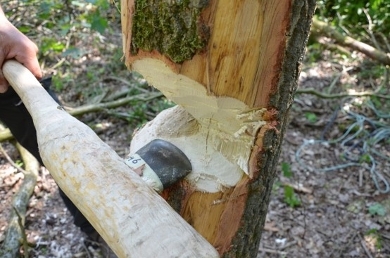
The Laboratory for Material Culture Studies at the Faculty of Archaeology in Leiden has one of the biggest collections of experimental tools in the world. These tools serve as a reference for the study of use-wear traces conducted in this lab, which are largely focused on the wetlands of the Lower Rhine Basin. There is thus a longstanding interest in experimental archaeology and use-wear studies. This experience and tradition in experimental archaeology, combined with the Laboratory’s capabilities in properly processing the datasets makes the Material Culture Studies group the institution to execute such a complex archaeological experiment.
Materials and methods
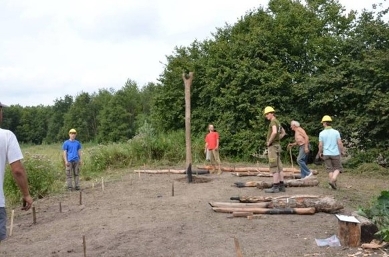
The reconstruction is based on a house plan from the site of Haamstede-Brabers, in the province of Zeeland, dated c. 2500 BC and attributed to the Vlaardingen culture. We selected this house because it is in a wetland location, it is relatively small and the house plan not overlain by later structures. The location of the Horsterwold, owned by the National Forestry Service, provided a unique location for this experiment, as all building material could be obtained nearby. The tools were all replicas of known Mesolithic and Neolithic implements with a few informal wooden tools. As the tools used would be included in the reference collection for use-wear studies, they were documented microscopically before use.
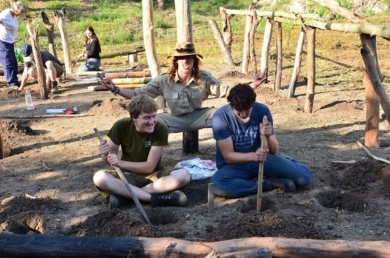
During the building process every time a tool was used, a new form had to be filled in by the user, listing time used, material and motion. Dental casts were regularly made as we could not do microscopic study in the field. In so doing we documented the entire history of use for each tool. We also calculated all materials needed as well as labour. All of these data were entered into a database and all tools were examined for traces of use.
The entire building process was analysed from the perspective of the chaîne opératoire, linking tools, labour input and materials. This provided us insight into aspects like scheduling, seasonality and the sequence of different actions.
Results and conclusions

Data are still being processed but a few results are already apparent. We built the house in 4 weeks with 2-3 experienced builders and 10-15 students. Our estimate is that this type of house, with its simple construction with locally obtained materials, can be made in two weeks. It also does not require much expertise. The 120 tools were used a total of 19,602 minutes of real contact time. Stone axes proved to be a very effective and fast tool to cut the trees, although bone and antler axes and adzes did the job as well. Wooden tools, especially digging sticks, made up 25% of the total tool use time. The roofing material chosen, summer reeds, which were folded over the batten, were painful to collect but once harvested, this way of roofing proved to be fast and highly effective.
Follow up
The Horsterwold project will be published in a book as well as in several articles. One of the articles was published in The Bulletin of Primitive Technology.

We will also repeat the Horsterwold experiment by reconstructing the same house plan again in the town of Vlaardingen. This is a public initiative, initiated and organized by the Federatie Broekpolder and financed by public funding. Again local volunteers will actively participate. The construction is planned for the summer of 2016. We have gained a lot of experience during the Horsterwold experiment and we will implement our new insights in this new experiment.





